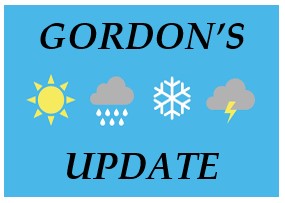By Gordon McCraw, Meteorologist for the Tillamook County Pioneer
Tuesday, October 4, 2022
Weather
A weak disturbance moved across earlier today and caused the marine layer to push well inland and thicken so we were again cloudy all day. The marine clouds remain tonight, and the patchy fog returns with the calm winds, the low near 49.
We do get to see a little of the sun tomorrow afternoon after the morning patchy fog clears and some of the clouds break up, the winds becoming westerly 5-10, highs near 69. As usual, the marine clouds return tomorrow night along with some patchy fog after the winds die off, lows near 52.
The ridge of high pressure strengthens again Thursday but the marine clouds continue to cover the coastal region so another mostly cloudy day, the fog burning off mid morning, the afternoon winds become northwesterly 5-10, highs near 70. More marine clouds Thursday night, calm winds, lows near 52.
The fair, mild, and dry conditions continue for the weekend, starting with Friday we see partly sunny skies, the high near 69, then with partly cloudy nighttime skies, the low near 51. Finally, Saturday looks mostly sunny and 70, then Sunday looks mostly sunny and 72. We still see the partly cloudy nights, lows near 52.
The Columbus Day forecast, another mostly sunny day, with the ridge possibly weakening, the high only near 68.
Speaking of Columbus Day
Many Oregonians remember the “Columbus Day Storm” from October 12, 1962 that significantly impacted the Pacific Northwest. The storm started as remnants of Typhoon Freda that started in the Northwest Pacific on September 28th.
The storm is considered to be one of the most intense storms to strike the region since 1948. The heavy rain and winds caused about $3-$5 billion in damage (2013 values) and contributed to 46 fatalities and hundreds of injuries and left over a million people without electricity. The peak winds were felt as the storm passed close by on October 12. At Oregon’s Cape Blanco, an anemometer that lost one of its cups registered wind gusts in excess of 145 miles per hour (233 kilometers per hour); some reports put the peak velocity at 179 mph (288 km/h). The north Oregon coast Mt. Hebo radar station reported winds of 170 mph (270 km/h).[8]
At the Naselle Radar Station in the Willapa Hills of southwest Washington, a wind gust of 160 mph (260 km/h) was observed.[7]
In Salem, Oregon, a wind gust of 90 mph (140 km/h) was observed.[7]
At Corvallis, Oregon, an inland location in the Willamette Valley, one-minute average winds reached 69 miles per hour (111 km/h), with a gust to 127 mph (204 km/h), before the station was abandoned due to “power failure and instruments demolished”. Observations at the weather station resumed the next day.[7]
About 80 miles (130 km) to the north, at Portland, Oregon’s major metropolitan area, measured wind gusts reached 116 mph (187 km/h) at the Morrison Street Bridge in downtown Portland.
A peak gust of 92 mph (148 km/h) was observed in Vancouver, Washington at Pearson Field, around 9 miles (14 km) to the north of downtown Portland.
The Columbus Day Storm outranks all other natural disasters in the state in terms of destruction and cost, including the 1903 Heppner Flood and the Great Gale of 2007.


